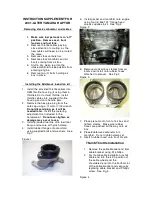
||
DRIVER SUPPORT
* Option/accessory.
360
1. Tap the
Park out
button in the center display's
Function view.
2. Use the turn signal to indicate the direction in
which the vehicle should leave the parking space.
3. Follow the instructions provided in the center
display. The procedure is the same as when park-
ing the vehicle.
The steering wheel may turn back slightly when
the function is completed and the driver may
have to turn the back before leaving the parking
space.
If PAP determines that the driver can leave the
parking space without assistance, the function
will deactivate before the vehicle is completely
out of the space.
Related information
•
•
•
Park Assist Pilot (PAP)
*
limitations
The PAP function may be limited in certain situa-
tions.
The PAP parking sequence is cancelled
A parking sequence will be cancelled:
•
if the vehicle is driven too fast: above approx.
4 mph (7 km/h)
•
if the driver taps
Cancel
in the center display
•
if the driver moves the steering wheel with
sufficient force.
•
if the anti-lock brakes or Electronic Stability
Control are activated (e.g., if a wheel begins
to spin or lose traction)
In such cases, a text message will explain why
the parking sequence was cancelled.
•
PAP will not function correctly if its sen-
sors are obstructed by dirt, snow, etc.
•
In certain situations, PAP may not be able
to measure a parking space. This could
be due to external sources of sound (e.g.,
a vehicle's horn, tires on wet asphalt,
pneumatic brakes, noise from a motorcy-
cle's exhaust, etc.) emitting ultrasound
using approximately the same frequen-
cies as PAP.
Points to keep in mind
PAP is a parking aid only and the driver should
always be prepared to take control and cancel a
parking sequence. This can be due to one or
more of the following factors:
•
PAP's function is based on the way that the
vehicles are parked behind and in front of
your parking space. If they are, for example,
parked too close to the curb, there is a risk
that your vehicle's tires or wheel rims could
be damaged by the curb during the parking
procedure.
•
PAP is intended to provide parking assis-
tance on straight streets, not sections of
street with curved or irregular curbs. Be sure
that your vehicle is parallel to the curb when
PAP measures the parking space.
•
PAP may not be able to provide parking
assistance on narrow streets due to lack of
space to maneuver the vehicle. In situations
like this, it may help to drive between
1.5-5.0 ft (0.5-1.5 m) from the side of the
road where the parking space is located.
•
Use only approved tires with the correct infla-
tion pressure because this affects PAP's
capacity to provide parking assistance.
Changing to a different approved tire size
may affect PAP's parameters. Consult a
trained and qualified Volvo service technician.
Summary of Contents for S 90 2017
Page 1: ...OWNER S MANUAL ...
Page 2: ......
Page 14: ......
Page 15: ...INTRODUCTION ...
Page 58: ......
Page 59: ...SAFETY ...
Page 96: ......
Page 97: ...INSTRUMENTS AND CONTROLS ...
Page 182: ......
Page 183: ...CLIMATE ...
Page 208: ......
Page 209: ...LOADING AND STORAGE ...
Page 225: ...LOADING AND STORAGE 223 Load anchoring eyelets p 216 Loading p 214 ...
Page 226: ......
Page 227: ...LOCKS AND ALARM ...
Page 253: ...DRIVER SUPPORT ...
Page 365: ...STARTING AND DRIVING ...
Page 412: ......
Page 413: ...INFOTAINMENT ...
Page 462: ......
Page 463: ...WHEELS AND TIRES ...
Page 492: ......
Page 493: ...MAINTENANCE AND SERVICING ...
Page 529: ...MAINTENANCE AND SERVICING 527 ...
Page 543: ...SPECIFICATIONS ...
Page 558: ......
Page 569: ......
Page 570: ...TP 23148 English USA Canada AT 1717 MY18 Copyright 2000 2017 Volvo Car Corporation ...
















































